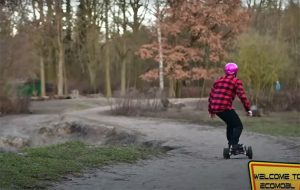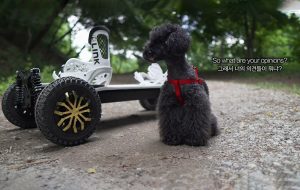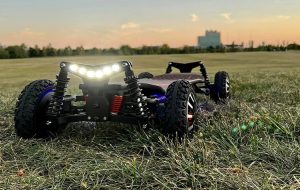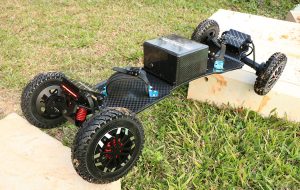Electric mountain boards offer riders a unique way to experience the great outdoors. However, mastering the basics of controlling your board can be daunting for beginners. In this article, we’ll review fundamental electric mountain board riding techniques to help you become more confident and comfortable on your board.

Basic Stance and Positioning
The right stance and positioning on an electric mountain board are essential for control, balance, and safety. Riders should place their feet shoulder-width apart, with knees bent to absorb impacts. One foot should be slightly in front of the other for directional control. It is important to keep the body centered over the board, neither leaning too far forward nor backward.
Riders should keep their arms out for balance rather than folding them in. Maintaining an upright yet poised posture allows for quick shifts in weight and leaning that enable sharp turns and corrections. Bending the knees and slightly crouching provides a lower center of gravity, which improves stability at higher speeds or over rough terrain.
Shifting weight by straightening one leg or leaning into a turn helps execute maneuvering and changes in direction. Leaning into curves distributes weight to the outside foot, allowing riders to turn tighter. Bracing with the arms also helps navigate turns and bumps. Positioning, balance, and a good stance are essential for controlling an electric mountain board, especially for beginners. With practice, the proper stance and body positioning will become second nature.
Starting and Stopping
Locate the throttle on your hand-held controller to start riding an electric mountain board.
Gently squeeze the throttle to begin accelerating and picking up speed.
Release the throttle to the coast at a steady speed or decelerate gradually.
Squeeze the brake:
Squeeze the button on the remote control to stop the board.
Apply the brake slowly to avoid skidding the tires. The harder you squeeze the brake, the more power will be cut from the motor and the faster you decelerate.
Practice braking at different intensities to understand how it impacts your speed.
For more control and maneuverability, get a feel for the speed range you can achieve at different throttle positions. Finding the ‘engagement point’ where the motor accelerates the board takes practice. Remember, you can always speed up or slow down, so start conservatively and get a feel for the throttle and brake response.
Turning the throttle on and off or applying partial throttle and braking allows for finer speed control and the ability to navigate obstacles. Using the controls smoothly will make riding more stable and less jerky. Take time to get familiar with how the board accelerates, decelerates, and handles at different speeds. Starting, stopping, and controlling the speed of an electric mountain board takes coordination and experience. With regular riding, the controls will feel completely natural.

Turning
Making turns on an electric mountain board takes practice to master. Two main techniques are carving turns and leaning turns. Carving involves shifting your weight and leaning into the turn while maintaining speed. Leaned turns require more sudden shifts in weight and momentum to change directions sharply at a lower speed.
To carve a turn:
Begin gently in the direction you want to go while still applying throttle. Shift your weight by straightening one leg or rising on the toes of one foot. As the board starts to lean, continue the turn by balancing on the edge of the tire. Apply more throttle to maintain or increase momentum through the turn. Lean in the opposite direction to straighten out and continue riding.
For leaned turns, release the throttle to the coast and quickly shift your entire body in the desired direction of travel. Lean into the turn while straightening the opposite leg for balance. Providing an extra lean with an arm also helps execute the turn. Once the board straightens out, reapply the throttle to pick up speed again.
The stance and positioning technique also applies to turning. Keeping knees bent, arms out, and remaining as balanced and centered as possible over the board makes turning easier. Tight turns require even more balance and control. Practice turning at different speeds and intensities to get a feel for how the board responds and how to stabilize yourself effectively as a rider.
Mastering turning on an electric mountain board takes practice and patience. Start with basic lean turns at slower speeds before progressing to carving and sharper turns as your control and confidence improve. Turning is key to maneuvering and navigating the board, so continue riding and turning consistently. With regular practice, turning will become second nature.

Descending Hills
Descending hills on an electric mountain board safely takes finesse. It is important to use the brake properly and maintain good balance. As you head down a hill, gradually release the throttle to the coast at a moderate speed. Apply the brake intermittently by squeezing the lever on your remote control. Short bursts of braking will slow your speed without skidding the tires.
Lean into the hill slightly while braking to keep the front-end light. The steeper the hill, the more you will need to lean forward to prevent the front of the board from lifting. Staying balanced over the center of the board provides the most control. Make microscopic shifts of your weight as needed to counteract any tilting.
As your speed decreases around turns, apply more brake to keep momentum in check. Conversely, if needed, release the brake for a few seconds to maintain a safe speed going straight downhill. It is always easier to slow down than to accelerate out of a dangerous situation. Practice braking at different intensities before descending steeper hills.
Descending consistently, controlled speed is the safest approach, especially when learning. Practice starting, braking, and turning on slight to moderate hills without traffic and few obstacles. Get used to how the board feels at different speeds and how to stabilize yourself. Build up your confidence in braking and handling the board.
With regular riding practice, descending hills will become second nature. The keys are using the brake effectively yet smoothly, maintaining balance and control, starting gradually, and building up your speed and skills over time. Take it slow and be cautious, especially on steeper descents. Safety should be the top priority whenever riding an electric mountain board. With experience, you’ll be zipping down slopes in no time!
Ascending Hills
Climbing hills on an electric mountain board takes practice to master. Gaining momentum for going up slopes starts with applying throttle and leaning into the hill while shifting your weight accordingly.
As you approach the base of a hill, accelerate by squeezing the throttle on your remote control. Increase speed moderately while remaining balanced over the board. Leaning forward slightly into the hill will help keep the front-end light without lifting off the ground. Make minor shifts of your weight between your legs to maintain balance at a higher speed.
Approach the bottom section of the hill at a speed that allows you to lean comfortably into the ascent without losing control. The steeper the hill, the more you will need to lean forward. Shifting more weight over the front of the board will allow it to climb at an optimal angle without bogging down. Continue applying throttle steadily as you go up the hill.
Leaning harder into the hill on smaller slopes provides extra traction for a better ascent. You may need to take it at an angle rather than straight up on steep hills. Make wide and gradual turns as needed to continue momentum up the grade. Releasing the throttle briefly and straightening the board will allow it to level before making another angled approach up the hill.
Practice hill climbs starting at smaller inclines without traffic. Begin by leaning into gradual rises at a moderate throttle setting. Get a feel for how the board responds and find the right balance point of leaning in and straightening out as needed. Build up your speed and endurance for going up hills over multiple riding sessions.
As with other techniques, frequent practice will make ascending hills second nature. Start small, throttle smoothly, and stay balanced while leaning into the hill as required for your speed and grade. Build up your skills and confidence over time. Safety first—never lose control going uphill! With enough experience, your electric mountain board will quickly zip up slopes.

Speed Control
Maintaining control of your speed is essential on an electric mountain board. Adjusting the throttle and brake properly allows riders to regulate their momentum for safer riding and more thrilling adventures. Some key tips for speed control include:
- Gradually increase throttle to pick up speed. Make minor throttle adjustments rather than wide-open squeezes. This allows for more nuanced speed control and the ability to react quickly.
- Release the throttle to coast at a steady speed. Take your foot off the throttle for a few seconds to maintain momentum at a constant velocity. Reapply the throttle as needed to prevent slowing down too much. Coasting is an easy way to control speed without using the brake.
- Apply short bursts of braking. Squeeze the brake lever in quick, intermittent pulses. This will slow your speed incrementally without skidding the tires. The harder and longer you brake, the more speed will be lost. Practice braking with timed releases of the lever for finer control.
- Practice braking at different intensities. Experiencing how the board responds to light, moderate, and heavy braking helps develop an intuitive sense of speed control. Know the braking ‘sweet spot’ for different speeds.
- Shift between throttle, coasting, and braking. For ultimate speed control, practice transitioning quickly between accelerating, coasting, and braking based on the terrain, conditions, and experience level. With practice, finding the right balance of speed will become second nature.
- Relate speed to terrain difficulty. Get a feel for how much speed is appropriate and comfortable on different types of terrain. Start on less technical trails before progressing to more difficult courses. Speed control is especially important on rougher, more obstacle-ridden terrain.
With regular riding practice, speed control becomes instinctual. Take it slow, start on easier terrain, and build your confidence and control over time. Safety is the priority, so speed control will allow you to enjoy riding at a pace that suits your skills. Practice and patience lead to mastering speed on an electric mountain board.
In conclusion, learning to control an electric mountain board takes time, practice, and patience. As a beginner, focus on mastering basic stance, positioning, starting, stopping, turning, descending and ascending hills, and speed control. With consistent practice, these skills will become second nature, allowing you to enjoy the thrilling experience of electric mountain boarding. Remember, safety should always be your top priority while riding, so start slow, build your skills, and have fun exploring the great outdoors!
Read More
- How To Choose The Right Remote Control For Electric Skateboard
- Ecomobl Mini Electric Skateboard Real Reviews
- Are Electric Skateboards Dangerous
- Shopping Guide Of Skateboard With Remote Control
- Electric Skateboard Vs Mountainboard Which Is Right For You




